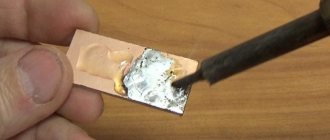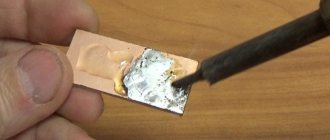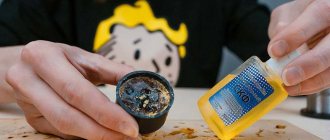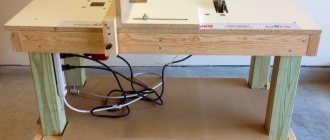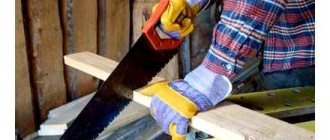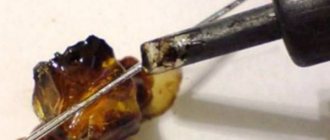Electrical appliances sometimes stop working and need to be repaired. The cause of the malfunction may be a failed microcircuit, any part, or a disconnected contact. Very often, problems can be solved at home by replacing a broken part or soldering a loose contact. You will need rosin for soldering and a soldering iron.
What is rosin
Rosin (full name colophon resin) is a glassy solid similar to amber, which is obtained from the resins of coniferous trees purified in a special way. It is absolutely insoluble in water, but easily soluble in alcohol, acetone, and gasoline.
In addition to the main name, words are added to it by which you can understand how it was obtained: pine (harpius), tallow, extraction, etc. The softening and melting temperature of rosin (from 50 to 130 °C) depends on the method of production, raw materials and chemical additives in the composition.
Rosin got its name from the ancient city of Kolophon, where “resin for bows” was produced and sold in large quantities. There was no talk of using rosin for soldering; at that time there was neither such a process nor parts requiring such a connection. Rosin was actively used in a variety of everyday situations. It was used to lubricate bow arrows and musical instrument bows. They filled the gaps between the boards and impregnated the hulls of ships, and used them in the manufacture of lubricants.
What are they made from?
Pine rosin is obtained by heat treatment of resin - the sap of coniferous trees, mainly pine. Water and turpentine are evaporated from it; after heat treatment, solid translucent pieces are formed, which are then cleaned chemically. This rosin contains no fatty acids, which can be very important when performing certain types of work. This type softens at 66-69 °C.
Extraction rosin is obtained by treating crushed wood with solvents, most often gasoline. This type is darker than all the others, it contains approximately 10% fatty acids, and it softens at a temperature of 58-60 °C.
Tall rosin is produced by distilling tall oil. This oil is a waste product from the pulp and paper industry. It softens at temperatures from 56 to 60 °C.
By the color of rosin you can determine its quality. If the shade is bright and saturated, the cleaning was not carried out according to technology and foreign impurities remain in the composition. They have a detrimental effect on properties and characteristics. The high-quality composition has a lemon tint. Gum rosin is considered the best among all types of rosin.
Application
Rosin is a mixture of resin acids and their isomers, which is a flux, i.e. a substance that removes oxide films, grease, and other contaminants from the metal surface and protects against oxidation and corrosion. Why do you need rosin for soldering?
The tip of the soldering iron heats the metal contacts, and an oxide film instantly forms on them, preventing the solder from joining the parts. To remove this obstacle you need rosin (or flux). It is used to treat surfaces and prepare them for applying solder.
Soldering process
If you need to solder, for example, a wire to a board, then:
- First you need to warm up the wire by applying a soldering iron to it, pressing it as tightly as possible.
- After a few seconds, the wire along with the soldering iron tip should be dipped into the rosin, it will boil and be evenly distributed. This way the wire is prepared for applying solder to it.
- Use the soldering iron tip to take a small part of the solder and apply it evenly, in a thin layer, to the wire. In this case, pellets and drops should not form. There should be no untreated areas; the result is the same wire, but in tin.
- Next, you need to clean the soldering iron tip with a metal sponge or cloth and, touching the rosin, run it over the board, creating a thin layer on its surface. The surfaces are ready for soldering.
- Then attach the wire to the board, ensuring maximum contact. Press the tip of a soldering iron with a thin layer of solder onto the wire and “iron” the joint several times for better heating.
- Then let it cool and check the connection for strength.
When soldering is carried out correctly, the surface of the joint is shiny, which means that it has maximum strength. If the surface is matte and looks loose, then the connection is weak.
Due to the ability of rosin to dissolve oxides of metals such as copper, lead, tin when heated, it effectively copes with this task at temperatures above 150 degrees. Rosin is used in electrical work as a natural flux. With its help, in addition to removing the oxide film, grease and contaminants, spreading is improved and the surface tension of the substance used as solder is leveled. At the same time, the seams are filled faster and the quality of the connection improves.
At home, the most common solder is low-melting tin. It is impossible to use rosin with refractory solders. Its boiling point is +250 °C, at which rosin evaporates; accordingly, the protective and cleaning properties of the flux also disappear when exposed to metal.
Non-standard methods
If there is no rosin nearby for soldering, you can use material for rubbing bows.
It's better cleaned. All properties are saved. The cost of replacement will be significant. Savvy craftsmen who have solders with flux suggest soaking it in alcohol and waiting until the rosin has completely dissolved. It takes a little time.
They say that such an alcoholic extract can successfully replace rosin. The alcohol component will gradually evaporate. The solid component meets the requirements for fluxes.
When working with old equipment, you can replace rosin with residues in places of old soldering. You need to touch the wire and soldering iron there and make a connection. This method is acceptable for extreme situations with not very high requirements for seams.
Types of flux
For different applications, rosin is available in pure and diluted form. There are three types of fluxes based on colophon resin: solid, liquid and gel. Liquid and gel-type fluxes are more expensive and difficult to produce.
It is acceptable to use rosin-based fluxes for small-sized components of a certain metal composition. Other types of fluxes are used for processing large compounds, complex alloys, rare metals and on an industrial scale.
- Solid flux is rosin in its pure form. It is the most popular and has both undoubted pros and cons. The main disadvantage is the inconvenience and inaccuracy of application to hard-to-reach solder areas.
- Flux based on an alcohol solution, diluted in equal proportions of alcohol and solid rosin. It is very convenient when applying it with a brush to the surfaces of parts that will be connected by soldering.
- Gel-based rosin flux. The viscous consistency allows you to accurately dose the applied composition and easily process the most difficult areas of the parts to be joined. The gel takes longer to dry compared to an alcohol-based composition. This gives some time for soldering; it is more plastic and pliable compared to solid rosin flux.
Liquid or gel flux is first applied with a brush to the soldering areas and begins to work without simultaneous exposure to temperature.
What kind of solder is best for soldering aluminum?
For soldering aluminum parts, it is advisable to use solder based on silicon, copper, aluminum, silver or zinc. For example 34A, which consists of aluminum (66%), copper (28%) and silicon (6%), or the more common TsOP-40 (Sn - 60%, Zn - 40%).
Interesting materials:
Is it possible to make an appointment with a doctor at another clinic? Is it possible to register at the passport office? Is it possible to pay for the traffic police exam? Can I charge the case without JBL headphones? Is it possible to force me to take a polygraph? Is it possible to marry several times? Is it possible to live in an apartment before inheriting? Is it possible to live in a basement? How to get to Victory Park? How to get from Samara to Kurumoch?
The main advantages of rosin
Main advantages:
- Does not conduct electricity.
- Low cost, available for sale almost everywhere.
- Retains its properties at negative temperatures.
- Not affected by moisture, not washed off with water
- Long shelf life.
- Prevents corrosion on metal structures, effectively removes oxide film from the surface of the material being processed, and degreases the product.
How can I replace rosin for soldering?
There are situations in which you need to solder parts, but there is no rosin at hand. In such cases, you can replace rosin with the following substances:
Aspirin
You can replace rosin-based flux with acid-based flux. Take regular aspirin from the medicine cabinet (effervescent is not suitable), or, as it is also called, acetylsalicylic acid, and use a tablet of this drug to solder the necessary parts. The tablet can be crushed, this powder can be dissolved in alcohol or water, and the highest concentration of acid can be produced.
Use the solution as a liquid composition for treating surfaces; you can also use a dry tablet as a solid flux for soldering. It is necessary to take into account that when using aspirin, acrid smoke with a strong unpleasant odor is released, so the room in which the work is carried out must be well ventilated.
Soldering fat
You can also use soldering oil instead of rosin-based flux. It spreads very well, covering the entire surface. Using solder fat it is easy to connect the necessary contacts. Only after soldering it is necessary to wash the joint with alcohol to remove any remaining grease. If this is not done, corrosion may develop in the future. Also, when carrying out work, you need to ventilate the room; heating the solder fat provokes the release of a specific odor.
Resin
For soldering products, you can use ordinary coniferous tree resin. The soldering process is the same as using solid flux. The resin melts well. It is not aggressive, so when using resin as a flux, additional protective measures do not need to be applied.
Amber
For soldering, instead of rosin, you can use amber; it has similar characteristics to it and will be a better replacement. But it makes sense to use it only in cases of absolute necessity, since amber is quite an expensive material and therefore it is better to consider other options for replacement.
Rosin for musical instruments
Rosin for musical instruments is a good alternative. But you need to take into account that this type is much more expensive than ordinary rosin for soldering.
All analogues can replace rosin, as they have similar properties. But, before using them, it is necessary to study the characteristics of each material and the nuances of its use in soldering.
Flaws
In addition to the positive aspects, there are also some disadvantages that can limit the use of the chemical element:
- It is strictly forbidden to use acids when working with radio circuits and small electronics. The properties of some compositions are such that the tracks are destroyed during the processing and growth of new conductive elements.
- The shelf life is underestimated due to the volatility of gases, so it will not be possible to purchase these fluxes with a reserve. There are also requirements for storage conditions, non-compliance with which can lead to damage to the material;
- The composition is harmful to humans if inhaled or in contact with skin. It is recommended to use personal protective equipment during mass work; soldering should be carried out in a well-ventilated area.
Read also: It’s easy to make a loom with your own hands
Making at home
You can make rosin yourself. The resin of all coniferous trees is suitable, but it is better to take pine. You can take a walk through the coniferous forest, taking with you a container for resin, a scraper, a spoon or a knife.
Only trees that have reached 30 cm in diameter are suitable for resin extraction. It is known that an adult pine tree produces no more than two liters of resin per year. Scientists have proven that resin is not a juice necessary for the normal functioning of a plant, but a means for healing its wounds.
A sufficient amount of resin can be obtained at logging sites, where it appears on cut trees and stumps, or it can be sent to a sawmill. Resin often appears on fresh lumber. The resin should be scraped with a scraper or spoon into a metal pot or jar.
The container filled with resin must be placed on fire. It makes sense to carry out this procedure outdoors since the resin will melt and boil when heated, releasing turpentine vapor. The contents of the pot must be stirred periodically to remove foam and debris. The resin must be heated until it stops boiling and the release of vapors stops.
After the boiling stops, a thick transparent mass of a characteristic yellow color, similar to amber, will remain in the pot. It needs to be poured into molds and allowed to cool. It is better to make forms from cardboard or stiff paper. You can also use plastic containers, but it’s easier to get ready-made rosin from cardboard containers. If inclusions of debris are visible in the resulting rosin, it can be filtered through a fine metal mesh.
Acids with stearin
It happens that there is nothing suitable for replacement nearby.
Then any acid except concentrated sulfuric and nitric acid is suitable for removing oxides. To prevent oxidation of the metal, you can thoroughly clean it and the solder, then coat them with stearin. Stearin (paraffin) can be taken from candles.
Before applying a protective layer to the metal, stearin must be melted without overheating. The protective layer will prevent contact with oxygen. Soldering should be carried out under the stearin layer.
Some craftsmen, in order to replace rosin, spread the well-known BF-6 glue onto the cleaned metal surface. In this case, you need to solder while pressing the soldering iron firmly.
The above methods are a “first aid” for a solderer. In unexpected situations, a way out can always be found using simple and accessible means. But still, for the quality of soldering, it is better to use special tools.
